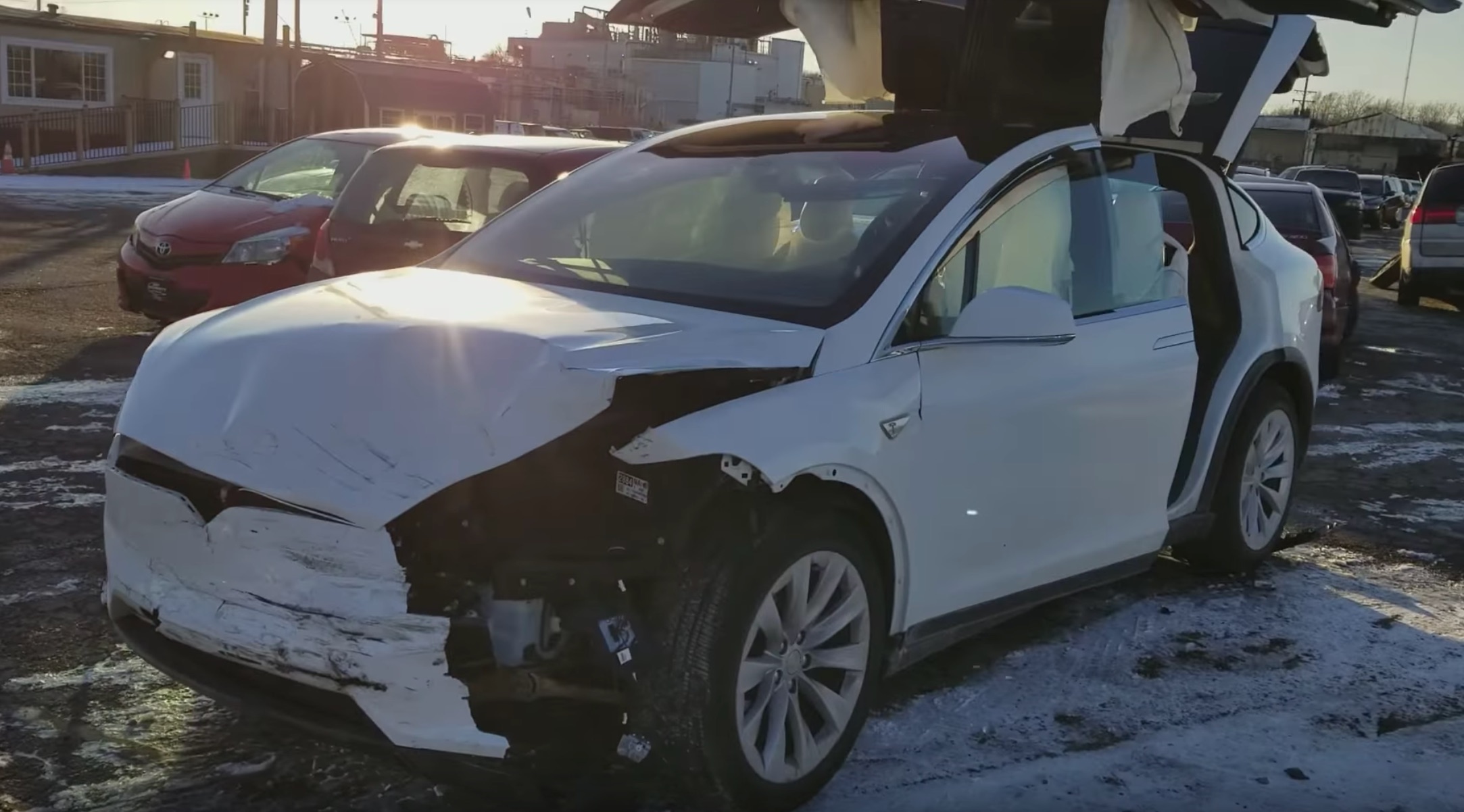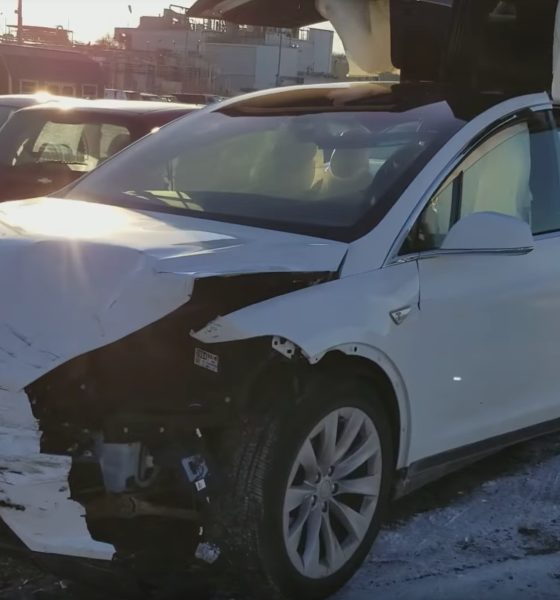

News
This Tesla Model X accident highlights the vehicle’s 5-star safety rating
Tesla takes pride in the Model X’s stellar safety ratings from the National Highway Traffic Safety Administration (NHTSA), which awarded a full 5-star crash rating for all categories and subcategories of the electric SUV. These excellent safety scores were put to the test recently, when a Tesla Model X 75D got involved in a serious crash in Dayton, Ohio.
The aftermath of a Model X 75D accident was shared by Jordan Hart, a Tesla enthusiast and owner of YouTube’s Driving The Future channel. According to Hart, a small sedan ran a red light in front of his wife’s Model X 75D, which was traveling at about 55 mph. The accident resulted in a collision that damaged the electric SUV’s front left side.
The impact from the accident completely ripped off the Model X 75D’s left headlight and a large chunk of its bumper, exposing the internals of the vehicle. The hood of the heavyweight SUV was also bent out of shape.
Despite the significant impact, however, the Tesla was able to protect Hart’s wife by cocooning her in the safety of Model X 75D’s twelve airbags. We saw a similar occurrence last year when a Tesla Model X saved the life of an entire family and their pet after it was involved in a horrific traffic accident at an intersection. “I waited 4 years for this one and would wait 4 more if that is what it took to protect my family like this.” said the driver of the Model X at the time.
In a statement to Teslarati, Hart stated that immediately after the collision, his wife was able to drive the Model X 75D to the side of the road. She was also able to exit the vehicle without any issues as well. The electric SUV then sent a message about the accident to Tesla, which immediately reached out to his wife.
Hart further stated that he was able to utilize his smartphone’s Tesla app to navigate directly to his wife and her Model X 75D’s location. He and his spouse were then informed of the nearest shop where the electric SUV could be towed to. The shop also gave Hart and his wife a quote for the Model X 75D’s repairs.
The quote for the Model X 75D’s repairs as a result of the accident was estimated to be $40,000. While not specifically stated by Hart, the steep bill might be due to the Model X’s all-aluminum panels, many of which need to be replaced entirely.
While unfortunate, the recent accident involving a Model X 75D seems to validate the NHTSA’s safety ratings for the electric SUV. Due to the vehicle’s weight and low center of gravity, the Model X was able to absorb the impact from the violent collision without rolling over.
During its announcement of the Model X’s 5-star safety rating, Tesla estimated that passengers of the electric SUV have a 93 percent probability of walking away from a crash without any serious injury. Looking at the aftermath of the recent Model X accident, it appears that Tesla’s estimate is quite accurate.
Jordan Hart runs Driving the Future, a YouTube channel dedicated to Tesla and its vehicles. Just last summer, Hart set a cross country record in a Model S 85D, traveling from Los Angeles to New York in 51 hours and 47 minutes. The feat was done in order to raise awareness to the human trafficking trade. According to Hart, his cross country Model S run, together with his wife’s recent Model X accident, just proved how reliable and safe the carmaker’s vehicles really are.
“The record run proved to me how reliable Teslas are. This unfortunate incident has proven to me how safe they are. I intend to never let my wife drive anything else.”

News
Tesla FSD fleet is nearing 7 billion total miles, including 2.5 billion city miles
As can be seen on Tesla’s official FSD webpage, vehicles equipped with the system have now navigated over 6.99 billion miles.

Tesla’s Full Self-Driving (Supervised) fleet is closing in on almost 7 billion total miles driven, as per data posted by the company on its official FSD webpage.
These figures hint at the massive scale of data fueling Tesla’s rapid FSD improvements, which have been quite notable as of late.
FSD mileage milestones
As can be seen on Tesla’s official FSD webpage, vehicles equipped with the system have now navigated over 6.99 billion miles. Tesla owner and avid FSD tester Whole Mars Catalog also shared a screenshot indicating that from the nearly 7 billion miles traveled by the FSD fleet, more than 2.5 billion miles were driven inside cities.
City miles are particularly valuable for complex urban scenarios like unprotected turns, pedestrian interactions, and traffic lights. This is also the difference-maker for FSD, as only complex solutions, such as Waymo’s self-driving taxis, operate similarly on inner-city streets. And even then, incidents such as the San Francisco blackouts have proven challenging for sensor-rich vehicles like Waymos.
Tesla’s data edge
Tesla has a number of advantages in the autonomous vehicle sector, one of which is the size of its fleet and the number of vehicles training FSD on real-world roads. Tesla’s nearly 7 billion FSD miles then allow the company to roll out updates that make its vehicles behave like they are being driven by experienced drivers, even if they are operating on their own.
So notable are Tesla’s improvements to FSD that NVIDIA Director of Robotics Jim Fan, after experiencing FSD v14, noted that the system is the first AI that passes what he described as a “Physical Turing Test.”
“Despite knowing exactly how robot learning works, I still find it magical watching the steering wheel turn by itself. First it feels surreal, next it becomes routine. Then, like the smartphone, taking it away actively hurts. This is how humanity gets rewired and glued to god-like technologies,” Fan wrote in a post on X.
News
Tesla starts showing how FSD will change lives in Europe
Local officials tested the system on narrow country roads and were impressed by FSD’s smooth, human-like driving, with some calling the service a game-changer for everyday life in areas that are far from urban centers.

Tesla has launched Europe’s first public shuttle service using Full Self-Driving (Supervised) in the rural Eifelkreis Bitburg-Prüm region of Germany, demonstrating how the technology can restore independence and mobility for people who struggle with limited transport options.
Local officials tested the system on narrow country roads and were impressed by FSD’s smooth, human-like driving, with some calling the service a game-changer for everyday life in areas that are far from urban centers.
Officials see real impact on rural residents
Arzfeld Mayor Johannes Kuhl and District Administrator Andreas Kruppert personally tested the Tesla shuttle service. This allowed them to see just how well FSD navigated winding lanes and rural roads confidently. Kruppert said, “Autonomous driving sounds like science fiction to many, but we simply see here that it works totally well in rural regions too.” Kuhl, for his part, also noted that FSD “feels like a very experienced driver.”
The pilot complements the area’s “Citizen Bus” program, which provides on-demand rides for elderly residents who can no longer drive themselves. Tesla Europe shared a video of a demonstration of the service, highlighting how FSD gives people their freedom back, even in places where public transport is not as prevalent.
What the Ministry for Economic Affairs and Transport says
Rhineland-Palatinate’s Minister Daniela Schmitt supported the project, praising the collaboration that made this “first of its kind in Europe” possible. As per the ministry, the rural rollout for the service shows FSD’s potential beyond major cities, and it delivers tangible benefits like grocery runs, doctor visits, and social connections for isolated residents.
“Reliable and flexible mobility is especially vital in rural areas. With the launch of a shuttle service using self-driving vehicles (FSD supervised) by Tesla in the Eifelkreis Bitburg-Prüm, an innovative pilot project is now getting underway that complements local community bus services. It is the first project of its kind in Europe.
“The result is a real gain for rural mobility: greater accessibility, more flexibility and tangible benefits for everyday life. A strong signal for innovation, cooperation and future-oriented mobility beyond urban centers,” the ministry wrote in a LinkedIn post.
News
Tesla China quietly posts Robotaxi-related job listing
Tesla China is currently seeking a Low Voltage Electrical Engineer to work on circuit board design for the company’s autonomous vehicles.

Tesla has posted a new job listing in Shanghai explicitly tied to its Robotaxi program, fueling speculation that the company is preparing to launch its dedicated autonomous ride-hailing service in China.
As noted in the listing, Tesla China is currently seeking a Low Voltage Electrical Engineer to work on circuit board design for the company’s autonomous vehicles.
Robotaxi-specific role
The listing, which was shared on social media platform X by industry watcher @tslaming, suggested that Tesla China is looking to fill the role urgently. The job listing itself specifically mentions that the person hired for the role will be working on the Low Voltage Hardware team, which would design the circuit boards that would serve as the nervous system of the Robotaxi.
Key tasks for the role, as indicated in the job listing, include collaboration with PCB layout, firmware, mechanical, program management, and validation teams, among other responsibilities. The role is based in Shanghai.
China Robotaxi launch
China represents a massive potential market for robotaxis, with its dense urban centers and supportive policies in select cities. Tesla has limited permission to roll out FSD in the country, though despite this, its vehicles have been hailed as among the best in the market when it comes to autonomous features. So far, at least, it appears that China supports Tesla’s FSD and Robotaxi rollout.
This was hinted at in November, when Tesla brought the Cybercab to the 8th China International Import Expo (CIIE) in Shanghai, marking the first time that the autonomous two-seater was brought to the Asia-Pacific region. The vehicle, despite not having a release date in China, received a significant amount of interest among the event’s attendees.








